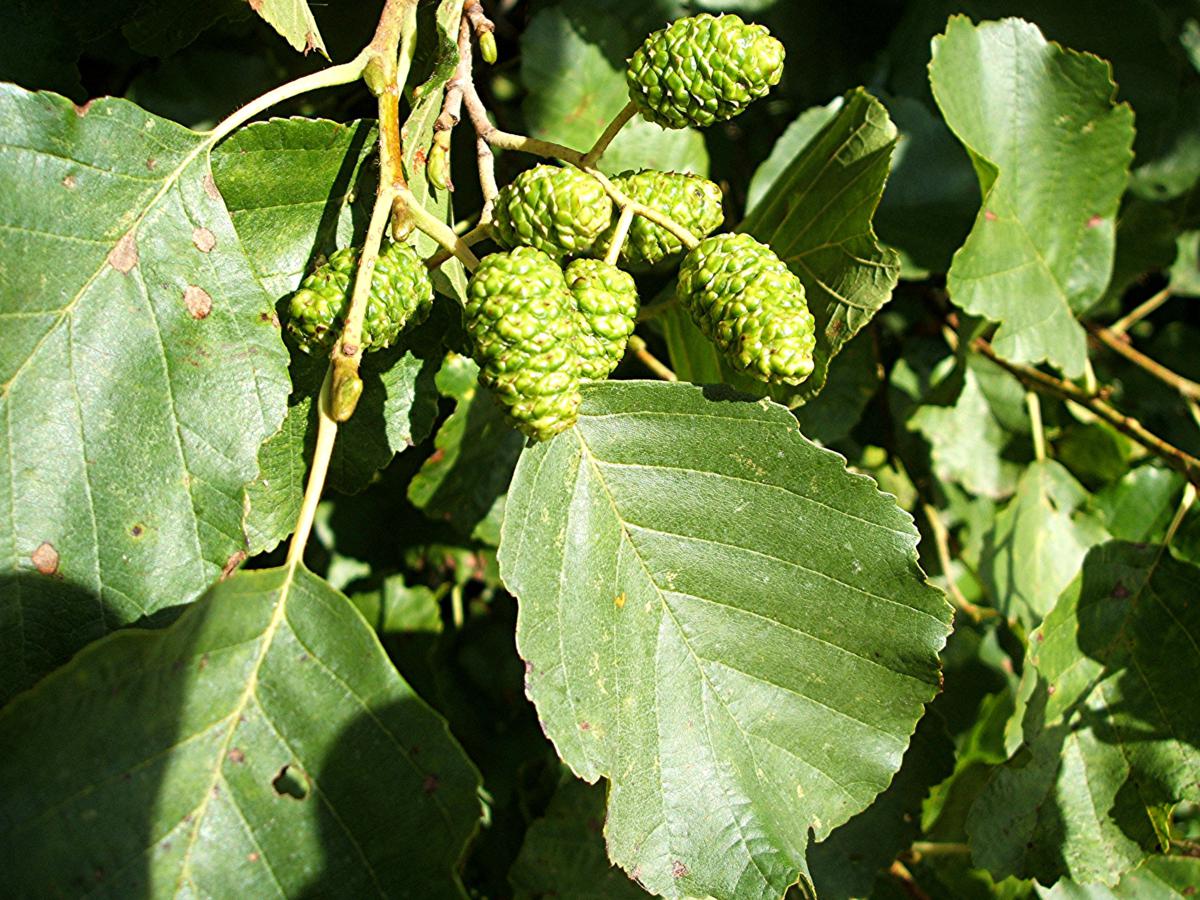Silver Alder
(Alnus incana incana)

Description
Alnus incana incana, commonly known as the Silver Alder or Grey Alder, is a deciduous tree species belonging to the Betulaceae family. It is a subspecies of the broader Alnus incana species, which encompasses several other varieties. Renowned for its striking silver-gray bark and adaptable nature, Alnus incana incana is widely appreciated for its ornamental value and environmental benefits. This article will delve into the taxonomy, distribution, characteristics, ecological significance, and cultivation of this captivating tree species. Taxonomy Alnus incana incana falls under the Kingdom Plantae, Division Magnoliophyta, Class Magnoliopsida, Order Fagales, Family Betulaceae, and Genus Alnus. Its scientific name, Alnus incana, is derived from the Latin word "alnus," meaning "alder," and "incana," meaning "hoary" or "gray," which aptly describes its distinctive bark color. Distribution and Habitat The Silver Alder is native to various regions of Europe and Asia, primarily found in countries such as Austria, Belgium, Czech Republic, Finland, Germany, Hungary, Poland, Russia, Slovakia, Sweden, and Switzerland. It typically thrives in moist environments, including riverbanks, wetlands, and forest edges. Alnus incana incana demonstrates remarkable adaptability, tolerating both acidic and alkaline soils, although it prefers moist, loamy soils. Characteristics Size and Growth: The Silver Alder is a medium-sized tree, reaching heights of 15 to 25 meters (50 to 80 feet) upon maturity. It has an upright and broadly pyramidal crown, with branches that extend horizontally. Bark: One of the most striking features of Alnus incana incana is its smooth, silvery-gray bark, which develops prominent lenticels as it ages. Leaves: The leaves of the Silver Alder are alternate, simple, and ovate with serrated edges. They are dark green on the upper surface and paler beneath, measuring approximately 5 to 12 centimeters (2 to 5 inches) in length. Flowers: The tree produces inconspicuous, small, pendulous flowers called catkins, which appear in early spring before the leaves emerge. The male catkins are yellowish-brown and elongated, while the female catkins are smaller and green. Fruits: Alnus incana incana bears small, woody, cone-like fruits known as strobiles or cones. These cones, which contain numerous seeds, persist on the tree throughout the winter. Roots: The Silver Alder possesses a shallow, fibrous root system that aids in its adaptation to waterlogged soils. Ecological Significance Nitrogen Fixation: Like other alder species, Alnus incana incana has a symbiotic relationship with nitrogen-fixing bacteria called Frankia. The tree forms nodules on its roots, which house these bacteria. The bacteria convert atmospheric nitrogen into a usable form, enriching the soil with nitrogen and enhancing its fertility. This ability makes the Silver Alder an essential species for ecological restoration projects and reforestation efforts. Erosion Control: With its extensive root system, Alnus incana incana provides excellent erosion control along riverbanks and other water bodies. The roots bind the soil, preventing its erosion and reducing the risk of landslides. Wildlife Habitat: The tree's catkins serve as a vital food source for insects, while its seeds and buds are consumed by various bird species. Riparian Ecosystem Support: Due to its preference for moist habitats, the Silver Alder plays a crucial role in riparian ecosystems. It provides shade and habitat for aquatic organisms, such as fish and amphibians, while its fallen leaves contribute to the organic matter in the water, supporting a diverse array of microorganisms and invertebrates. Carbon Sequestration: Like all trees, Alnus incana incana helps mitigate climate change by sequestering carbon dioxide from the atmosphere. The tree's extensive root system and rapid growth contribute to its carbon storage capacity, making it an effective tool in carbon offset programs. Soil Improvement: Through its ability to fix nitrogen, the Silver Alder improves soil fertility and promotes the growth of other plant species in its vicinity. The tree's leaf litter also contributes to organic matter accumulation, enhancing soil structure and moisture retention. Cultivation and Uses Ornamental Value: Alnus incana incana is widely cultivated for its aesthetic appeal. Its distinctive silver-gray bark adds contrast and visual interest to landscapes, particularly during winter when other trees may lack color. Landscaping and Restoration: The tree's adaptability to various soil types and its tolerance for wet conditions make it a suitable choice for landscaping projects, particularly in riparian areas, wetlands, or sites prone to soil erosion. It is also commonly used in ecological restoration efforts to improve degraded ecosystems and support biodiversity. Timber and Wood Products: While not as commonly utilized for timber as some other alder species, Alnus incana incana can still provide high-quality wood. The wood is light in color and relatively soft, making it suitable for uses such as veneer, plywood, and furniture construction. Medicinal and Traditional Uses: In traditional medicine, various parts of the Silver Alder have been used for their potential medicinal properties. The bark has been used to treat fever and respiratory ailments, while the leaves were used to make herbal teas believed to have diuretic and detoxifying effects. Conclusion Alnus incana incana, or the Silver Alder, is a remarkable tree species with ornamental appeal and significant ecological value. Its silver-gray bark, adaptability to diverse soil conditions, nitrogen-fixing ability, and erosion control qualities make it a valuable asset in landscaping, restoration, and ecological conservation efforts. By understanding and appreciating the ecological significance of the Silver Alder, we can harness its benefits and contribute to a more sustainable and biodiverse environment.
Taxonomic tree:







